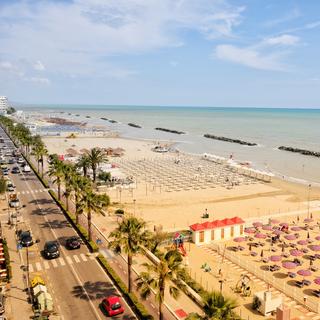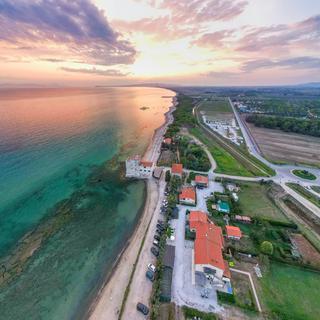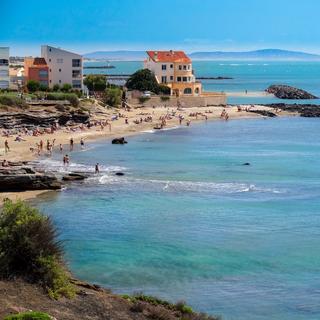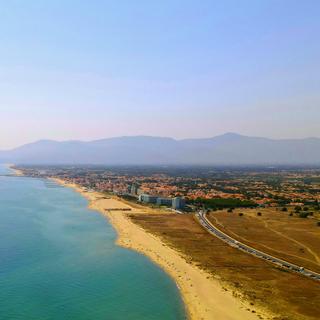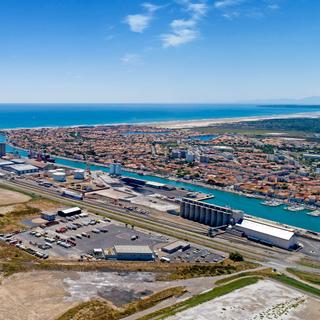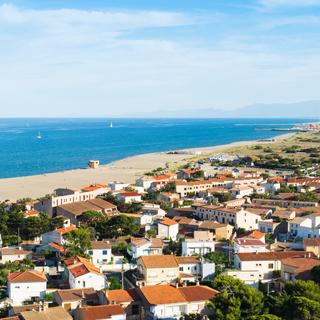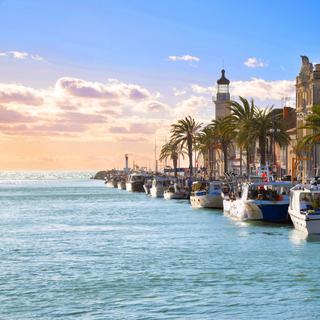
La Grande-Motte weather and climate

La Grande-Motte weather and climate
Day
30 °C
Night
18 °C
Sea
21 °C
Precipitation
19 mm
in month
Rainy days
3 days
in month
Daylight
15 hours
average
Sunshine
11 hours
average
Humidity
58 %
Weather charts for La Grande-Motte
Find more destinations like this
Destinations with similar weather to La Grande-Motte
Other destinations in Langedouc-Rousillon - France
Closest cities for La Grande-Motte
Weather overview for La Grande-Motte
Weather overview
The coastal town of La Grande-Motte in France generally experiences a temperate climate characterized by warm summers and mild winters. Daytime temperatures vary, beginning at an average of 12 °C (53 °F) in the brisk month of January and ascending to a toasty 30 °C (86 °F) in the zenith of July. The scarcity of precipitation is most pronounced in July, with barely 3 days experiencing rainfall, whereas October contrasts as the month with the most frequent rainfall, totaling 8 days. As evening descends, nocturnal temperatures span from a nippy 3 °C (37 °F) in January up to a balmy 18 °C (65 °F) in July. The annual aquatic temperature fluctuations aren't to be ignored, ranging from a cool 12 °C (53 °F) in frigid February to a warm 22 °C (71 °F) by the time August's heatwave rolls in.
January weather
In January, the modest daylight warmth peaks at 12 °C (53 °F) in La Grande-Motte, while the sea's chill is palpable at 12 °C (54 °F). As nightfall envelops the city, the temperature plummets to its yearly nadir at 3 °C (37 °F). An incremental increase in sunlit hours begins, cresting at 4 hours, alongside the apex of humidity, marked at 77 %.
February weather
The nascent elevation in daytime temperatures becomes evident in February, with a reading of 14 °C (56 °F), set against the backdrop of the sea's coldest embrace at 12 °C (53 °F). The gradual decrease in precipitation is mirrored by an uptick in nocturnal warmth to 3 °C (38 °F), and the successive climb in sun-infused hours reaches 5 hours.
March weather
March beholds a diminishing trend in rainfall frequency within La Grande-Motte, while a gentle decline in rain volume is measured at 39 mm (1.55 in). The chilly nights grow milder, stabilizing at 7 °C (44 °F), as the daytime warmth escalates to 17 °C (62 °F). Sunlight duration broadens further to 6 hours, even as the zenith of wind velocity is noted at 6 m/s.
April weather
As spring progresses, La Grande-Motte witnesses an inaugural rise in oceanic warmth to 13 °C (56 °F). The atmosphere reciprocates, as daylight temperatures climb to 19 °C (66 °F). The onset of increased rainfall materializes at 57 mm (2.26 in), accompanied by a burgeoning count of 8 days marked by showers. The nocturnal thermometer reads 9 °C (47 °F), while sunlit hours ascend to 7 hours.
May weather
May ushers in a consistent warming trend, with daylight temperatures reaching 23 °C (73 °F), while sea waters gently heat to 16 °C (61 °F). Rainy days now embark on a decline, numbering 7 days, and the ebbing showers contribute to a lighter precipitation tally at 46 mm (1.81 in). The extended duration of sun gives way to 8 hours, as evenings grow appreciably warmer at 13 °C (55 °F).
June weather
June's emergence is marked by an escalation in diurnal heat, averaging 27 °C (81 °F), and an aligning surge in maritime temperatures reaching 19 °C (66 °F). The prelude to tourist season is signaled by receding rain, with its frequency now at 5 days and volume at 29 mm (1.15 in). Night temperatures climb to a comfortable 16 °C (60 °F).
July weather
The zenith of summer arrives in July, with the apex of daytime warmth at 30 °C (86 °F), and a parallel rise in ocean temperatures registering 21 °C (70 °F). The zenithal sparsity of rain is evident at 3 days, and the apogee of solar exposure is revealed through 11 hours. Nights are at their peak warmth at 18 °C (65 °F).
August weather
August's gentle retreat in land heat, at 30 °C (85 °F), contrasts the sea's climactic warmth of 22 °C (71 °F). Rainy days experience a modest increase to 5 days, and solar exposure begins to wane at 10 hours. The height of tourist season continues.
September weather
September's narrative is one of descent, with daytime warmth retracting to 26 °C (78 °F) and the sea's embrace cooling to 20 °C (68 °F). Tourist season remains vibrant. The augmentation of rainfall begins, totaling 68 mm (2.66 in), with an increased incidence of 6 days. The onset of evening chill is noted at 15 °C (60 °F).
October weather
October's crisp air is felt during the day, with a decline to 21 °C (70 °F), and at night, as the mercury slides to 12 °C (53 °F). The seaside cools further, and the culmination of rainy days is evident at 8 days. The dimming daylight is well perceived at a shorter 6 hours.
November weather
November sees a persistent decline in both land and sea temperatures, with respective readings of 15 °C (60 °F) and 16 °C (61 °F). The fading daylight is further impacted by retreating rain days, now at 8 days, and a lessening deluge at 71 mm (2.80 in). The nights crisp up at 7 °C (44 °F).
December weather
The year concludes in La Grande-Motte with daytime chilliness setting in at 12 °C (53 °F), while marine waters cool to 14 °C (57 °F). The rain continues its retreat, marked by a mere 7 days. Night temperatures edge down to a frosty 4 °C (39 °F), as sunlight contracts to its lowest at 4 hours.
FAQs
What is the lowest night temperature in La Grande-Motte during January?
The nightly chill in January in La Grande-Motte can drop to a wintry 3 °C (37 °F).
How does the sea temperature in La Grande-Motte vary in February?
February's frigid sea temperature in La Grande-Motte hovers around 12 °C (53 °F).
What is the maximum wind speed in March in La Grande-Motte?
A brisk gust can be expected with March winds reaching speeds up to 6 m/s.
How much rainfall can I anticipate in April in La Grande-Motte?
April showers bring a modest influx of rain, totaling around 57 mm (2.26 in).
What length of daylight can be expected in La Grande-Motte during May?
The sun deems to grace us longer, bestowing an average of 8 hours of daylight in May.
How does the number of sunny hours change in June in La Grande-Motte?
June generously extends our sunlight quota to around 10 hours per day.
What is the peak temperature during the day in La Grande-Motte in July?
July boasts the year’s summit of heat, with daytime highs soaring to 30 °C (86 °F).
Does the sea temperature peak in August in La Grande-Motte?
August's waters are at their warmest, basking at a toasty 22 °C (71 °F).
What trend in precipitation is noticeable in September in La Grande-Motte?
September's skies become grayer, as rain events climb to an average of 6 days.
What is the average night temperature in October in La Grande-Motte?
When October evenings drape La Grande-Motte, expect the temperature to average around 12 °C (53 °F).
How many hours of sunlight are there in November in La Grande-Motte?
Sunlight becomes scarce in November, dipping to roughly 5 hours of clarity per day.
What is the sea temperature in December in La Grande-Motte?
December's sea currents turn brisk, with temperatures falling to an average of 14 °C (57 °F).


